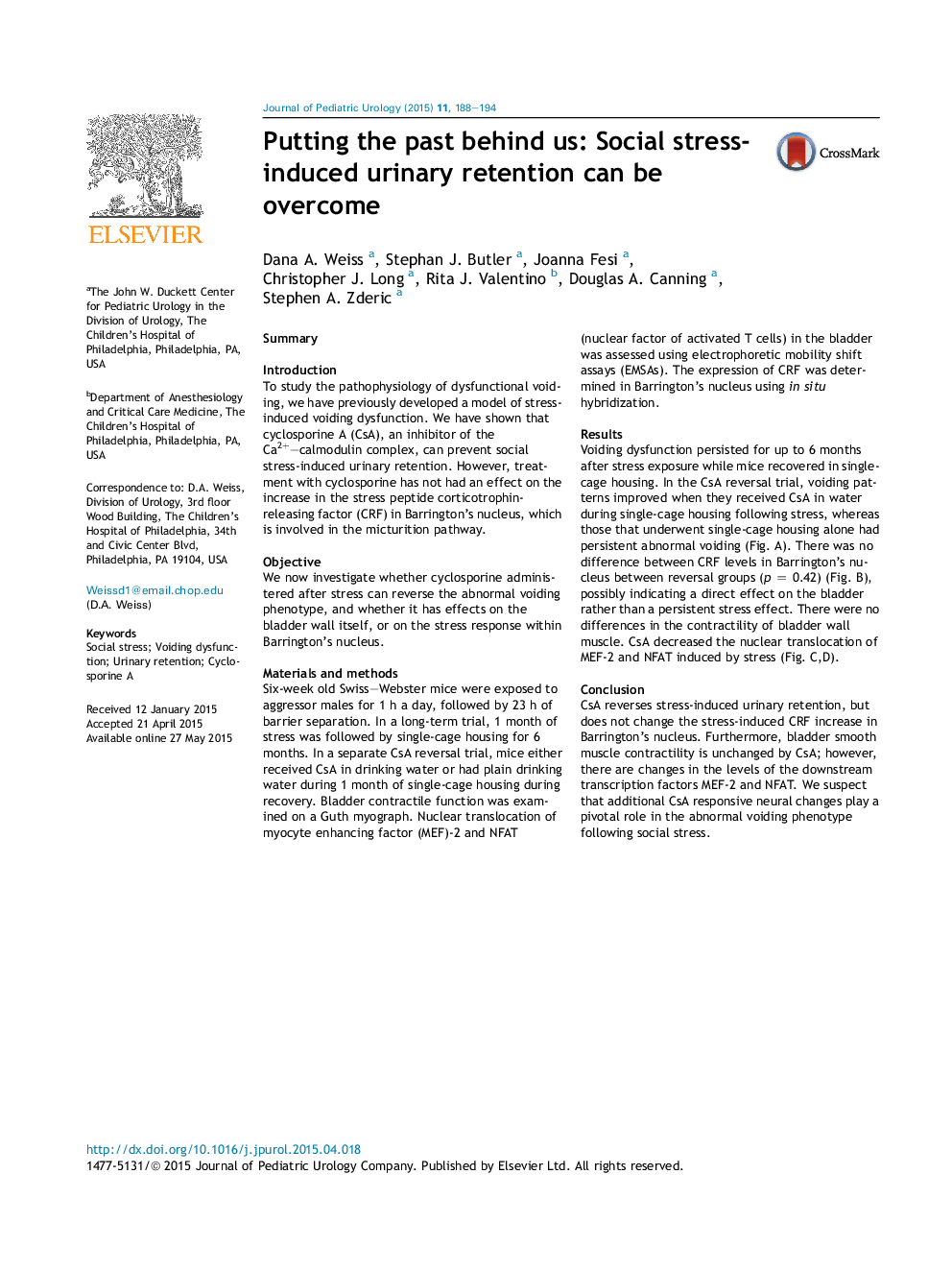| Article ID | Journal | Published Year | Pages | File Type |
|---|---|---|---|---|
| 4162177 | Journal of Pediatric Urology | 2015 | 7 Pages |
SummaryIntroductionTo study the pathophysiology of dysfunctional voiding, we have previously developed a model of stress-induced voiding dysfunction. We have shown that cyclosporine A (CsA), an inhibitor of the Ca2+–calmodulin complex, can prevent social stress-induced urinary retention. However, treatment with cyclosporine has not had an effect on the increase in the stress peptide corticotrophin-releasing factor (CRF) in Barrington's nucleus, which is involved in the micturition pathway.ObjectiveWe now investigate whether cyclosporine administered after stress can reverse the abnormal voiding phenotype, and whether it has effects on the bladder wall itself, or on the stress response within Barrington's nucleus.Materials and methodsSix-week old Swiss–Webster mice were exposed to aggressor males for 1 h a day, followed by 23 h of barrier separation. In a long-term trial, 1 month of stress was followed by single-cage housing for 6 months. In a separate CsA reversal trial, mice either received CsA in drinking water or had plain drinking water during 1 month of single-cage housing during recovery. Bladder contractile function was examined on a Guth myograph. Nuclear translocation of myocyte enhancing factor (MEF)-2 and NFAT (nuclear factor of activated T cells) in the bladder was assessed using electrophoretic mobility shift assays (EMSAs). The expression of CRF was determined in Barrington's nucleus using in situ hybridization.ResultsVoiding dysfunction persisted for up to 6 months after stress exposure while mice recovered in single-cage housing. In the CsA reversal trial, voiding patterns improved when they received CsA in water during single-cage housing following stress, whereas those that underwent single-cage housing alone had persistent abnormal voiding (Fig. A). There was no difference between CRF levels in Barrington's nucleus between reversal groups (p = 0.42) (Fig. B), possibly indicating a direct effect on the bladder rather than a persistent stress effect. There were no differences in the contractility of bladder wall muscle. CsA decreased the nuclear translocation of MEF-2 and NFAT induced by stress (Fig. C,D).ConclusionCsA reverses stress-induced urinary retention, but does not change the stress-induced CRF increase in Barrington's nucleus. Furthermore, bladder smooth muscle contractility is unchanged by CsA; however, there are changes in the levels of the downstream transcription factors MEF-2 and NFAT. We suspect that additional CsA responsive neural changes play a pivotal role in the abnormal voiding phenotype following social stress.Figure. (A) Average number of voids in 10-week-old control Swiss–Webster male mice, compared with number of voids after 1 month of stress, and after stress followed by 1 month of single-cage housing alone or 1 month of single-cage housing with CsA administration. (B) There was no significant difference between stress and recovery groups on fluorescent in situ hybridization analysis; however, all were significantly increased from control (C,D) Electrophorectic mobility shift assay (EMSA) performed for quantification of nuclear protein levels of myocyte enhancing factor 2 (MEF-2) and nuclear factor of activated T cells (NFAT) using infrared-labeled DNA probes.Figure optionsDownload full-size imageDownload high-quality image (408 K)Download as PowerPoint slide
